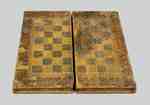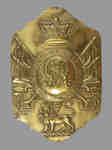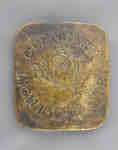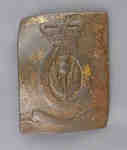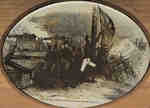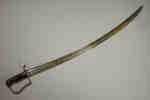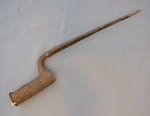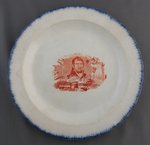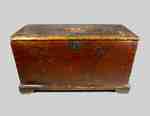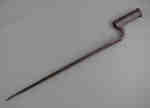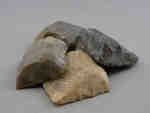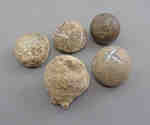Résultats




- Sword and Scabbard- Dr. Cyrus Sumner
 The origin of the sword is unknown and there are no distinct markings on it. It is believed however, that the sword would have been carried by the Light Cavalry (Light Dragoons and the Hussars). The sword has a steel blade and a wooden grip wrapped in leather and bounded …
The origin of the sword is unknown and there are no distinct markings on it. It is believed however, that the sword would have been carried by the Light Cavalry (Light Dragoons and the Hussars). The sword has a steel blade and a wooden grip wrapped in leather and bounded …  The origin of the sword is unknown and there are no distinct markings on it. It is believed however, that the sword would have been carried by the Light Cavalry …
The origin of the sword is unknown and there are no distinct markings on it. It is believed however, that the sword would have been carried by the Light Cavalry … - Chessboard- c.1800
 A chessboard made of tooled leather with a blackgammon board inside. When folded, the board is made to look like a book. On the side is printed "History of Asia" with additional decorative designs. Penciled letters inside read "JWN" underlined with the price $1.50. Theory states that the board was …
A chessboard made of tooled leather with a blackgammon board inside. When folded, the board is made to look like a book. On the side is printed "History of Asia" with additional decorative designs. Penciled letters inside read "JWN" underlined with the price $1.50. Theory states that the board was …  A chessboard made of tooled leather with a blackgammon board inside. When folded, the board is made to look like a book. On the side is printed "History of Asia" …
A chessboard made of tooled leather with a blackgammon board inside. When folded, the board is made to look like a book. On the side is printed "History of Asia" … - Powder Horn- Dr. Cyrus Sumner
 A powder horn with brass fittings at both ends. There is one brass ring remaining to which some material such as hide or leather would have been fastened for carrying purposes. At the narrow end there is also a small moveable "catch". It is believed that the powder horn was …
A powder horn with brass fittings at both ends. There is one brass ring remaining to which some material such as hide or leather would have been fastened for carrying purposes. At the narrow end there is also a small moveable "catch". It is believed that the powder horn was …  A powder horn with brass fittings at both ends. There is one brass ring remaining to which some material such as hide or leather would have been fastened for carrying …
A powder horn with brass fittings at both ends. There is one brass ring remaining to which some material such as hide or leather would have been fastened for carrying … - Leather Document Box
 A white leather document box lined with an issue of The Bee newspaper.
A white leather document box lined with an issue of The Bee newspaper.  A white leather document box lined with an issue of The Bee newspaper.
A white leather document box lined with an issue of The Bee newspaper. - Clay Pipe with Masonic Insignia c.1800
 A white clay pipe that has a Masonic insignia design on the bowl. The broken stem is two inches in length
A white clay pipe that has a Masonic insignia design on the bowl. The broken stem is two inches in length  A white clay pipe that has a Masonic insignia design on the bowl. The broken stem is two inches in length
A white clay pipe that has a Masonic insignia design on the bowl. The broken stem is two inches in length - Stove Pipe Shako Plate c.1803-1812
 This is a regulation issue plate for a stove pipe shako that was supplied to infantry regulars between 1803 and 1812. There is a Hanoverian crown on the crest with the “GR” cipher of George III surrounded by a Garter containing the motto of the Royal family. The motto is …
This is a regulation issue plate for a stove pipe shako that was supplied to infantry regulars between 1803 and 1812. There is a Hanoverian crown on the crest with the “GR” cipher of George III surrounded by a Garter containing the motto of the Royal family. The motto is …  This is a regulation issue plate for a stove pipe shako that was supplied to infantry regulars between 1803 and 1812. There is a Hanoverian crown on the crest with …
This is a regulation issue plate for a stove pipe shako that was supplied to infantry regulars between 1803 and 1812. There is a Hanoverian crown on the crest with … - Glengarry Light Infantry Cross Belt Plate c.1812-1816
 This is a square cross belt plate of the Glengarry Light Infantry, a Canadian Provincial Corps. It has a scotch thistle in the centre with “GLENGARRY LIGHT INFANTRY” inscribed around it. The Glengarry Light Infantry participated at the following engagements: Salmon River, Ogdensburg, York, Fort George, Sackett’s Harbour, Oswego, Lundy’s …
This is a square cross belt plate of the Glengarry Light Infantry, a Canadian Provincial Corps. It has a scotch thistle in the centre with “GLENGARRY LIGHT INFANTRY” inscribed around it. The Glengarry Light Infantry participated at the following engagements: Salmon River, Ogdensburg, York, Fort George, Sackett’s Harbour, Oswego, Lundy’s …  This is a square cross belt plate of the Glengarry Light Infantry, a Canadian Provincial Corps. It has a scotch thistle in the centre with “GLENGARRY LIGHT INFANTRY” inscribed around …
This is a square cross belt plate of the Glengarry Light Infantry, a Canadian Provincial Corps. It has a scotch thistle in the centre with “GLENGARRY LIGHT INFANTRY” inscribed around … - 1st (Royal Scots) Regiment Cross Belt Plate c.1812
 This is a brass cross belt plate of the 1st (Royal Scots) Regiment. It is rectangular with an oval scotch thistle in the centre with lettering (illegible) around it and a crown on top. There is also a banner at the bottom. The belt plate measures 5.5cm x7cm and 2 …
This is a brass cross belt plate of the 1st (Royal Scots) Regiment. It is rectangular with an oval scotch thistle in the centre with lettering (illegible) around it and a crown on top. There is also a banner at the bottom. The belt plate measures 5.5cm x7cm and 2 …  This is a brass cross belt plate of the 1st (Royal Scots) Regiment. It is rectangular with an oval scotch thistle in the centre with lettering (illegible) around it and …
This is a brass cross belt plate of the 1st (Royal Scots) Regiment. It is rectangular with an oval scotch thistle in the centre with lettering (illegible) around it and … - War of 1812 Engravings: Fort George, Fort Niagara and Winfield Scott at Queenston
 These are three engravings, most likely from a newspaper or other late 19th century literature, originally, and placed onto tiles. It is believed that they were taken from Winfield Scott's autobiography. They have been mounted onto a wooden plaque by the donor with the name of Ambrose Vannater(donor’s ancestor) inscribed …
These are three engravings, most likely from a newspaper or other late 19th century literature, originally, and placed onto tiles. It is believed that they were taken from Winfield Scott's autobiography. They have been mounted onto a wooden plaque by the donor with the name of Ambrose Vannater(donor’s ancestor) inscribed …  These are three engravings, most likely from a newspaper or other late 19th century literature, originally, and placed onto tiles. It is believed that they were taken from Winfield Scott's …
These are three engravings, most likely from a newspaper or other late 19th century literature, originally, and placed onto tiles. It is believed that they were taken from Winfield Scott's … - American Regulation Issue Cavalry Sabre- c.1812
 This is an American regulation issue cavalry sabre that has a “US” inscription on one side of the curved blade and an “N. Ward” inscription on the other. The sword is made of forged steel and features a leather covered handle. It was reported to have been taken from an …
This is an American regulation issue cavalry sabre that has a “US” inscription on one side of the curved blade and an “N. Ward” inscription on the other. The sword is made of forged steel and features a leather covered handle. It was reported to have been taken from an …  This is an American regulation issue cavalry sabre that has a “US” inscription on one side of the curved blade and an “N. Ward” inscription on the other. The sword …
This is an American regulation issue cavalry sabre that has a “US” inscription on one side of the curved blade and an “N. Ward” inscription on the other. The sword … - Brown Bess Socket Mount Bayonet
 This original Brown Bess socket mount bayonet is vintage War of 1812. It was purchased in the Niagara area and likely has a long local provenance.
This original Brown Bess socket mount bayonet is vintage War of 1812. It was purchased in the Niagara area and likely has a long local provenance.  This original Brown Bess socket mount bayonet is vintage War of 1812. It was purchased in the Niagara area and likely has a long local provenance.
This original Brown Bess socket mount bayonet is vintage War of 1812. It was purchased in the Niagara area and likely has a long local provenance. - Personal Seals of Sir Isaac Brock
 Two orange coloured seals containing the impression of the personal seal of Sir Isaac Brock. The seal depicts a crest containing a lion in the upper portion and an eagle with its wings spread in the lower portion, which represent strength, clarity of vision and courage. Below the crest is …
Two orange coloured seals containing the impression of the personal seal of Sir Isaac Brock. The seal depicts a crest containing a lion in the upper portion and an eagle with its wings spread in the lower portion, which represent strength, clarity of vision and courage. Below the crest is …  Two orange coloured seals containing the impression of the personal seal of Sir Isaac Brock. The seal depicts a crest containing a lion in the upper portion and an eagle …
Two orange coloured seals containing the impression of the personal seal of Sir Isaac Brock. The seal depicts a crest containing a lion in the upper portion and an eagle … - Major General Brown, Niagara. Plate
 Major General Zac Brown was in charge of the crew of the Niagara during the Battle of Lake Erie.
Major General Zac Brown was in charge of the crew of the Niagara during the Battle of Lake Erie.  Major General Zac Brown was in charge of the crew of the Niagara during the Battle of Lake Erie.
Major General Zac Brown was in charge of the crew of the Niagara during the Battle of Lake Erie. - Dr. Cyrus Sumner's Medical Supply Trunk
 Size: 35 inches long x 14.5 inches wide x 19 inches high
Size: 35 inches long x 14.5 inches wide x 19 inches high  Size: 35 inches long x 14.5 inches wide x 19 inches high
Size: 35 inches long x 14.5 inches wide x 19 inches high - Homemade Bayonet c.1812-1814
 A homemade bayonet that was designed to fit on the muzzle of a rifle or musket. It is of the styling favored most by the militia units during the War of 1812. Its unique length and lack of a rear reinforcing ring confirms this weapon was not manufactured by an …
A homemade bayonet that was designed to fit on the muzzle of a rifle or musket. It is of the styling favored most by the militia units during the War of 1812. Its unique length and lack of a rear reinforcing ring confirms this weapon was not manufactured by an …  A homemade bayonet that was designed to fit on the muzzle of a rifle or musket. It is of the styling favored most by the militia units during the War …
A homemade bayonet that was designed to fit on the muzzle of a rifle or musket. It is of the styling favored most by the militia units during the War … - British Bayonet c.1812-1814
 This is a bayonet that would have been designed to fit on the muzzle of a rifle or musket. Unique markings include a crown with the inscriptions “40”, “WHEELER”, “O”, and a “V” on the front of the blade. On the socket there are also inscriptions which are “QLI” (underlined) …
This is a bayonet that would have been designed to fit on the muzzle of a rifle or musket. Unique markings include a crown with the inscriptions “40”, “WHEELER”, “O”, and a “V” on the front of the blade. On the socket there are also inscriptions which are “QLI” (underlined) …  This is a bayonet that would have been designed to fit on the muzzle of a rifle or musket. Unique markings include a crown with the inscriptions “40”, “WHEELER”, “O”, …
This is a bayonet that would have been designed to fit on the muzzle of a rifle or musket. Unique markings include a crown with the inscriptions “40”, “WHEELER”, “O”, … - Brown Bess Bayonet
 This bayonet would have been designed to fit on the muzzle of a Brown Bess musket. It is slightly bent at the tip and unique markings on the blade include: a crown with “31”, “I. Salter” and what looks to be a carved “I”. The bayonet blade is 42cm long …
This bayonet would have been designed to fit on the muzzle of a Brown Bess musket. It is slightly bent at the tip and unique markings on the blade include: a crown with “31”, “I. Salter” and what looks to be a carved “I”. The bayonet blade is 42cm long …  This bayonet would have been designed to fit on the muzzle of a Brown Bess musket. It is slightly bent at the tip and unique markings on the blade include: …
This bayonet would have been designed to fit on the muzzle of a Brown Bess musket. It is slightly bent at the tip and unique markings on the blade include: … - British Bayonet Sheath
 This is a black leather bayonet sheath that measures 37.5cm in length. There is also a frog clip that was used to mount it on a belt. Stamped into the sheath near the frog clip are the markings: “E”, an arrow, “D” and a crown just above. These markings tell …
This is a black leather bayonet sheath that measures 37.5cm in length. There is also a frog clip that was used to mount it on a belt. Stamped into the sheath near the frog clip are the markings: “E”, an arrow, “D” and a crown just above. These markings tell …  This is a black leather bayonet sheath that measures 37.5cm in length. There is also a frog clip that was used to mount it on a belt. Stamped into the …
This is a black leather bayonet sheath that measures 37.5cm in length. There is also a frog clip that was used to mount it on a belt. Stamped into the … - Flint
 This is a piece of flint that was unearthed at one of Niagara’s Battlefields. It would have been used to light a flintlock musket when firing at the enemy.
This is a piece of flint that was unearthed at one of Niagara’s Battlefields. It would have been used to light a flintlock musket when firing at the enemy.  This is a piece of flint that was unearthed at one of Niagara’s Battlefields. It would have been used to light a flintlock musket when firing at the enemy.
This is a piece of flint that was unearthed at one of Niagara’s Battlefields. It would have been used to light a flintlock musket when firing at the enemy. - Muskets Balls
 These musket balls were found at one of Niagara's battlefield sites. It appears, due to their deformation, that they have been fired from a musket.
These musket balls were found at one of Niagara's battlefield sites. It appears, due to their deformation, that they have been fired from a musket.  These musket balls were found at one of Niagara's battlefield sites. It appears, due to their deformation, that they have been fired from a musket.
These musket balls were found at one of Niagara's battlefield sites. It appears, due to their deformation, that they have been fired from a musket.


